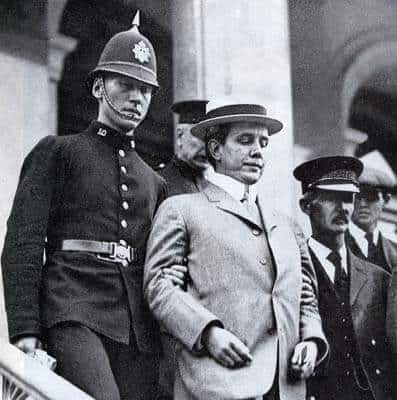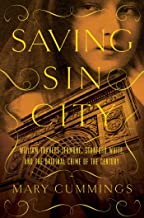by Mary Cummings
What's It About?
It was the original crime of the century.On June 25th, 1906, a shot rang out in Madison Square Garden, leaving of one of the greatest architects and most famous of New York’s socialites dead.
Stanford White, who designed New York’s Washington Square Arch, Madison Square Garden and the Rosecliff Mansion, was murdered by millionaire Harry Thaw as hundreds of people watched in horror. Years before his murder, White had fallen in love with a young actress named Evelyn Nesbit, who seemed to return his attentions. But White had two sides to him and one night, he assaulted Nesbit horribly.
Despite the attack, Evelyn Nesbit remained committed to White, falling even more deeply in in love with him – even after he no longer loved her. White explained his only wish was to stay on as her benefactor, paying for the education she and her brother received. In an effort to spark his jealousy, Nesbit made the mistake of getting close to Harry Thaw, the son of an incredibly well-known family who used their wealth to cover up the sadistic things he did for fun. Thaw was obsessed with Nesbit, and sensing her strong feelings for Stanford White, he obsessed over him, too.
While Thaw and Nesbit eventually married, his obsession with his wife did not stop just because she said, “I do.” Thaw’s obsession with White was growing and continued to do so until he killed the object of her affection that summer night.
What followed almost seems too strange to be true, but sometimes reality is stranger than fiction. Not only did a prosecutor with obvious politically ambitious fail to convict Thaw, he was hailed as a hero afterwards.
So where did it all go so wrong? How did the all-consuming power of money and corruption in the Gilded Age create the perfect storm that resulted in murder? To find the answer to these questions and more, we talked with historian and Saving Sin City author, Mary Cummings. Here, Cummings discusses her research, who Thaw really was and how the prosecutor lost the trial.
BookTrib: This book is so meticulously researched. How did you go about finding resources for this book?
Mary Cummings: I never would have been able to write this book without having access to the old newspapers online. Of course, many books have been written about Stanford White and I have quite the library now on him. The one thing that I did seek out was the biography of William Travers Jerome, which was absolutely necessary. I don’t think there’s another one out there, or at least I certainly didn’t find one. And, of course, the general research of the Gilded Age is saturated with books and articles, so it wasn’t difficult to find material there.
BookTrib: What drew you to the story of Stanford White and the tragedy that would befall him?
MC: Well, there is a personal angle to it. I grew up in Southampton, which every summer just turns into this very fashionable resort, ever since the late 19th century. Stanford White didn’t have a house out here, but his friends flocked to this place and he often joined them; he designed what I think are some of his most beautiful houses out here, which are simpler than some of the palaces he built elsewhere. They’re all in a shingle style, which I admire. That, of course, led me to the murder in 1906. I used to assume everyone had heard about it, but time goes on and now not everyone does.
BookTrib: But this book doesn’t read like a standard, historical biography. You bring in so many different elements are perspectives.
MC: I was looking for a new way to write about it and I actually found it in William Travers Jerome. I came across that biography and found that he was this swashbuckling crusader for justice in a very degraded New York City. He was nearly as famous as White at the time – just seen as this hero of the poor and the depressed. He was overturning convention everywhere he went and of course, particularly hair-raising were these of raids of the illicit gambling dens that he had to organize in secret, because the gambling dens would be tipped off by the police, who were totally corrupt and in the Tammany Machine’s pocket. But Jerome would take up this ax and break down these doors and then – never done before – he would turn the den into a court room, round up the gamblers and prosecute them. He was going to clean up Gotham.
He was very politically ambitious, very self-confident and always believed that he was the smartest man in the room – and he usually was. He was compared to Theodore Roosevelt, so he wanted to be governor and then maybe President.

BookTrib: But that dream came down around him, more or less, when he failed to prosecute millionaire Harry Kendall Thaw, who murdered Stanford White, correct?
MC: Jerome saw to it that the murderer was locked up, but of course, Thaw then got out. But he was on the political path and that day when Stanford White was murdered, June 25th, 1906, everything changed for him. At first he dismissed the murder: he thought it was just another jealousy killing, but he soon realized that he would be on the stage and the whole world would be watching. He came up against really strong odds because of the culture of the time, just this worshiping of money and of Evelyn Nesbit, the beautiful center of this love triangle. Money just ruled everything at the time and the Thaws had a limitless amount of money.
The other thing was the yellow press. They had made the truth totally irrelevant, which has resonance for today. We have “alternative facts” and fake news, and they just didn’t bother with anything. Everything was dramatized. The attitude about women was that they were either whores or up on a pedestal, and they just took up Evelyn Nesbit as this angel and Thaw as her avenger. It was very tough for Jerome to get into the real truth.
BookTrib: Let’s talk about Evelyn. She basically put on an act during the trial, while on the stand. She made White out to be this monster and fervently defended Thaw, even though he had this well-known sadistic side to him and had abused her horribly. Was there something in her background that could better explain this aspect of her character?
MC: What really was so interesting in writing this book is that they’re all such complex characters. But Evelyn just had this miserable childhood. Her father died young, her mother was hapless, and she had to take over. She really had to always make the most of whatever cards she was dealt. She admitted later that she really had loved White and that she had to do what her lawyer told her to, which was lie on the stand.
But she married Thaw when she saw no other way. She really didn’t have much talent as an actress and she was going to grow older, and what was she going to do? She had seen and grown up in poverty and was determined to never be impoverished like that again. So, she decided that Thaw was a way out. At first that she thought she could control him, because she did have some power over him. He was obsessed with her, just as White had been obsessed with her and the whole world became obsessed with her, and she thought she could make it work.
Even after he abused her, what made it palatable for her was that even though she knew she would have to put up with him, with all of his money at her disposal, really, she could do what she always dreamed of doing: she could travel to Europe, she could have everything she wanted and more – she would live lavishly, but she would pay a price.

BookTrib: Speaking about Thaw, he manipulated basically what was the beginning of the end of Evelyn’s relationship with her mother.
MC: Well, Evelyn’s mother was a very weak person. She practically sold Evelyn to White. She was very enamored with the money that she thought White had, but also with his celebrity. She resisted Thaw, really, because he offended her, but in the end she caved. She didn’t testify against him, she didn’t stand up for her daughter. She was feeding Jerome information that was damaging to Evelyn all throughout the trial. Thaw impressed her, in a sense, but not as much as White. It impressed her when they traveled through Europe and he treated her like royalty, but it wasn’t enough.
BookTrib: Historically, in the U.S. there is an over-arching stigma on mental illness – no matter the social class – and that’s really only beginning to change now. But, at that time, Thaw used the insanity defense. He was eventually placed into a mental hospital where Jerome (the prosecuting attorney) tried to ensure his stay. Later, however, Thaw was hailed as a hero. How did that happen?
MC: That was very much a result of the yellow press building him up as this hero, but also because of the psychiatry at the time. They had this idea that they could prove that he was only temporarily insane. They made a big deal of this one moment of rage when a man has to do something if his wife or his sister is abused by another man, and the public then just swallowed that whole. They thought Evelyn was this frail, beautiful victim – which she was, she was sexually assaulted- but they built up the melodrama to such a point that people were willing to accept that Thaw did what he had to do, which was kill White. Of course, the yellow press just destroyed White’s name.
BookTrib: Where do you think this obsession with Stanford White came from when he had all but ended his romantic interests in Evelyn as Thaw really became a permanent fixture in her life?
MC: White had everything Thaw wanted. Sooner or later, no matter what slight success he had socially, Thaw was shunned because he was just… beyond the beyond. He would brag about terrible things he had done, and he would break down and do bizarre things – he tried to ride a horse up the steps of the Union League Club. He did terrible things and he soon realized that everything White had – who was just lionized in high society, but also beloved in the bohemian world, just a great artist – Thaw would never get. He was an obsessive and he found White as his fixture.

BookTrib: Stanford White starts out as this man who just likes to have a good time, but then he falls in love with the underage Evelyn and sexually assaults her. After, he puts himself into a position where he’s not only her benefactor, but also pays for her brother’s education, so now he’s entangled in her family dynamic. He was the victim of Thaw’s rage which resulted in his murder. But, by the time the trial was over, he was just vilified. How do you see him?
MC: He had two sides to him. He had this charming, playful side and he could be incredibly generous with his friends, with everybody. But he had this terrible weakness for young women and somehow he had a blindness to the harm he was doing around him, to the suffering he created. His wife must have suffered, Evelyn suffered, and suffered even more when she was no longer his favorite.
BookTrib: You mentioned his wife there, Bessie. What happened to her and where was she during all of this? She kind of disappeared from the public eye, didn’t she?
MC: She did what a lot of women did and still sometimes do: she just shut her eyes to everything that was going on. Every weekend White came and played the family man. She spent more and more time away from the city, in their country house. I think she loved him. She lost his ardor but she kept his loyalty, and his fondness. They lived apart, mostly, and that’s just how their relationship was.
BookTrib: What should readers learn from this tragic tale and your telling of this story?
MC: I like to point out how many of the same issues are still being discussed today and are still with us. I mean, we have fake news and “alternative facts”. We’re still seeing the same corporate crime that goes back to the Gilded Age and we’re still struggling with it. We have people doing things that aren’t criminal on Wall Street, but they’re certainly not ethical. We’re even still struggling with the insanity plea. We also still have the problem of “can you love the art and not the artist?” Stanford White is seen as a respected and admired architect, but he was not a moral man. You read about him and you get drawn to him, but then you remember that he really had two very different sides. Those are the things that I think really make this relevant today.
Saving Sin City: William Travers Jerome, Stanford White, and the Original Crime of the Century is slated for release on May 1st.
Buy this Book!
Amazon





